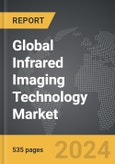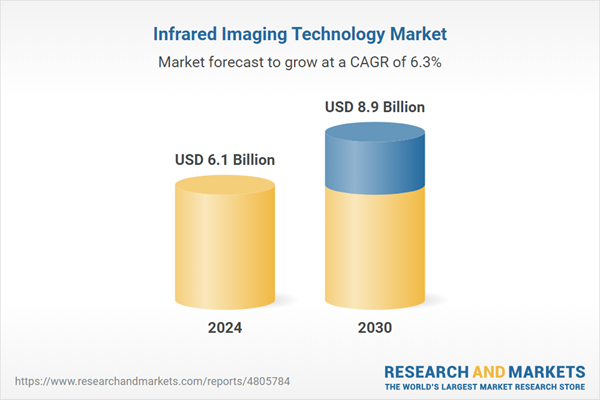The global market for Infrared Imaging Technology was valued at US$6.1 Billion in 2024 and is projected to reach US$8.9 Billion by 2030, growing at a CAGR of 6.3% from 2024 to 2030. This comprehensive report provides an in-depth analysis of market trends, drivers, and forecasts, helping you make informed business decisions. The report includes the most recent global tariff developments and how they impact the Infrared Imaging Technology market.
Technological advancements have significantly enhanced the resolution and sensitivity of infrared cameras, making them more effective and accessible for a wide range of applications. Modern developments have seen the miniaturization of thermal sensors, which has led to the integration of infrared imaging technology into consumer electronics such as smartphones and cars. For instance, some high-end vehicles now incorporate infrared cameras for night vision systems, helping drivers detect pedestrians or animals beyond the reach of headlights. Furthermore, advancements in image processing algorithms have improved the clarity and accuracy of thermal images, enabling finer distinctions and more precise readings of temperature differences. These enhancements not only increase the utility of infrared imaging in traditional sectors but also open up new applications in areas like environmental monitoring, where they can be used to detect gas leaks or monitor wildlife.
The growth in the infrared imaging market is driven by several factors, including the expanding range of applications enabled by technological advancements, increased demand for non-invasive diagnostic methods in healthcare, and the integration of infrared technology in consumer products. As industries seek more efficient and safer operational protocols, they increasingly turn to infrared imaging for non-contact and real-time analysis. The ongoing innovation in sensor technology, which has resulted in more compact, energy-efficient, and cost-effective cameras, has made infrared solutions accessible to a broader market, including small and medium-sized enterprises. Additionally, the rising emphasis on security and surveillance in response to global security concerns has propelled the use of infrared cameras in both public and private sectors. Moreover, consumer behavior that favors smart and automated technology, especially in home and automotive applications, is fostering further growth. These developments ensure robust expansion within the infrared imaging technology market, highlighting its critical role across various modern industrial and consumer landscapes.
Segments: Technology (Uncooled, Cooled); Application (Security & Surveillance, Monitoring & Inspection, Detection); Vertical (Industrial, Non-Industrial).
Geographic Regions/Countries: World; USA; Canada; Japan; China; Europe; France; Germany; Italy; UK; Spain; Russia; Rest of Europe; Asia-Pacific; Australia; India; South Korea; Rest of Asia-Pacific; Latin America; Argentina; Brazil; Mexico; Rest of Latin America; Middle East; Iran; Israel; Saudi Arabia; UAE; Rest of Middle East; Africa.
The analysts continuously track trade developments worldwide, drawing insights from leading global economists and over 200 industry and policy institutions, including think tanks, trade organizations, and national economic advisory bodies. This intelligence is integrated into forecasting models to provide timely, data-driven analysis of emerging risks and opportunities.
Global Infrared Imaging Technology Market - Key Trends & Drivers Summarized
Infrared imaging technology captures images based on the infrared radiation (heat) emitted by objects, as opposed to the visible light used in conventional photography. This technology extends human vision beyond the visible spectrum, enabling the detection of heat variations in various environments and situations. Infrared cameras, the primary tools for infrared imaging, convert infrared radiation into electronic signals, which are then processed to produce thermal images. These images reveal temperature variations across objects and spaces, highlighting differences that are invisible to the naked eye. Infrared imaging is utilized extensively in a number of fields including security and surveillance, where it helps in monitoring areas under low light or dark conditions; predictive maintenance, where it identifies heat anomalies in machinery before they lead to failures; and medical diagnostics, where it aids in detecting inflammation and poor blood flow.Technological advancements have significantly enhanced the resolution and sensitivity of infrared cameras, making them more effective and accessible for a wide range of applications. Modern developments have seen the miniaturization of thermal sensors, which has led to the integration of infrared imaging technology into consumer electronics such as smartphones and cars. For instance, some high-end vehicles now incorporate infrared cameras for night vision systems, helping drivers detect pedestrians or animals beyond the reach of headlights. Furthermore, advancements in image processing algorithms have improved the clarity and accuracy of thermal images, enabling finer distinctions and more precise readings of temperature differences. These enhancements not only increase the utility of infrared imaging in traditional sectors but also open up new applications in areas like environmental monitoring, where they can be used to detect gas leaks or monitor wildlife.
The growth in the infrared imaging market is driven by several factors, including the expanding range of applications enabled by technological advancements, increased demand for non-invasive diagnostic methods in healthcare, and the integration of infrared technology in consumer products. As industries seek more efficient and safer operational protocols, they increasingly turn to infrared imaging for non-contact and real-time analysis. The ongoing innovation in sensor technology, which has resulted in more compact, energy-efficient, and cost-effective cameras, has made infrared solutions accessible to a broader market, including small and medium-sized enterprises. Additionally, the rising emphasis on security and surveillance in response to global security concerns has propelled the use of infrared cameras in both public and private sectors. Moreover, consumer behavior that favors smart and automated technology, especially in home and automotive applications, is fostering further growth. These developments ensure robust expansion within the infrared imaging technology market, highlighting its critical role across various modern industrial and consumer landscapes.
Report Scope
The report analyzes the Infrared Imaging Technology market, presented in terms of units. The analysis covers the key segments and geographic regions outlined below.Segments: Technology (Uncooled, Cooled); Application (Security & Surveillance, Monitoring & Inspection, Detection); Vertical (Industrial, Non-Industrial).
Geographic Regions/Countries: World; USA; Canada; Japan; China; Europe; France; Germany; Italy; UK; Spain; Russia; Rest of Europe; Asia-Pacific; Australia; India; South Korea; Rest of Asia-Pacific; Latin America; Argentina; Brazil; Mexico; Rest of Latin America; Middle East; Iran; Israel; Saudi Arabia; UAE; Rest of Middle East; Africa.
Key Insights:
- Market Growth: Understand the significant growth trajectory of the Security & Surveillance segment, which is expected to reach US$5.2 Billion by 2030 with a CAGR of a 6.2%. The Monitoring & Inspection segment is also set to grow at 7.0% CAGR over the analysis period.
- Regional Analysis: Gain insights into the U.S. market, valued at $2.7 Billion in 2024, and China, forecasted to grow at an impressive 7.9% CAGR to reach $801.4 Million by 2030. Discover growth trends in other key regions, including Japan, Canada, Germany, and the Asia-Pacific.
Why You Should Buy This Report:
- Detailed Market Analysis: Access a thorough analysis of the Global Infrared Imaging Technology Market, covering all major geographic regions and market segments.
- Competitive Insights: Get an overview of the competitive landscape, including the market presence of major players across different geographies.
- Future Trends and Drivers: Understand the key trends and drivers shaping the future of the Global Infrared Imaging Technology Market.
- Actionable Insights: Benefit from actionable insights that can help you identify new revenue opportunities and make strategic business decisions.
Key Questions Answered:
- How is the Global Infrared Imaging Technology Market expected to evolve by 2030?
- What are the main drivers and restraints affecting the market?
- Which market segments will grow the most over the forecast period?
- How will market shares for different regions and segments change by 2030?
- Who are the leading players in the market, and what are their prospects?
Report Features:
- Comprehensive Market Data: Independent analysis of annual sales and market forecasts in US$ Million from 2024 to 2030.
- In-Depth Regional Analysis: Detailed insights into key markets, including the U.S., China, Japan, Canada, Europe, Asia-Pacific, Latin America, Middle East, and Africa.
- Company Profiles: Coverage of players such as Allied Vision Technologies GmbH, Axis Communications AB, Bruker Corporation, Cantronic Systems, General Dynamics Mission Systems, Inc. and more.
- Complimentary Updates: Receive free report updates for one year to keep you informed of the latest market developments.
Some of the 55 companies featured in this Infrared Imaging Technology market report include:
- Allied Vision Technologies GmbH
- Axis Communications AB
- Bruker Corporation
- Cantronic Systems
- General Dynamics Mission Systems, Inc.
- KARL STORZ SE & Co. KG
- L3Harris Technologies, Inc.
- New Imaging Technologies (NIT)
- Olympus Corporation
- Teledyne FLIR
- Thermo Fisher Scientific, Inc.
Tariff Impact Analysis: Key Insights for 2025
Global tariff negotiations across 180+ countries are reshaping supply chains, costs, and competitiveness. This report reflects the latest developments as of April 2025 and incorporates forward-looking insights into the market outlook.The analysts continuously track trade developments worldwide, drawing insights from leading global economists and over 200 industry and policy institutions, including think tanks, trade organizations, and national economic advisory bodies. This intelligence is integrated into forecasting models to provide timely, data-driven analysis of emerging risks and opportunities.
What’s Included in This Edition:
- Tariff-adjusted market forecasts by region and segment
- Analysis of cost and supply chain implications by sourcing and trade exposure
- Strategic insights into geographic shifts
Buyers receive a free July 2025 update with:
- Finalized tariff impacts and new trade agreement effects
- Updated projections reflecting global sourcing and cost shifts
- Expanded country-specific coverage across the industry
Table of Contents
I. METHODOLOGYII. EXECUTIVE SUMMARY2. FOCUS ON SELECT PLAYERSIII. MARKET ANALYSISCANADAITALYSPAINRUSSIAREST OF EUROPESOUTH KOREAREST OF ASIA-PACIFICARGENTINABRAZILMEXICOREST OF LATIN AMERICAIRANISRAELSAUDI ARABIAUNITED ARAB EMIRATESREST OF MIDDLE EASTIV. COMPETITION
1. MARKET OVERVIEW
3. MARKET TRENDS & DRIVERS
4. GLOBAL MARKET PERSPECTIVE
UNITED STATES
JAPAN
CHINA
EUROPE
FRANCE
GERMANY
UNITED KINGDOM
ASIA-PACIFIC
AUSTRALIA
INDIA
LATIN AMERICA
MIDDLE EAST
AFRICA
Companies Mentioned (Partial List)
A selection of companies mentioned in this report includes, but is not limited to:
- Allied Vision Technologies GmbH
- Axis Communications AB
- Bruker Corporation
- Cantronic Systems
- General Dynamics Mission Systems, Inc.
- KARL STORZ SE & Co. KG
- L3Harris Technologies, Inc.
- New Imaging Technologies (NIT)
- Olympus Corporation
- Teledyne FLIR
- Thermo Fisher Scientific, Inc.
Table Information
| Report Attribute | Details |
|---|---|
| No. of Pages | 535 |
| Published | April 2025 |
| Forecast Period | 2024 - 2030 |
| Estimated Market Value ( USD | $ 6.1 Billion |
| Forecasted Market Value ( USD | $ 8.9 Billion |
| Compound Annual Growth Rate | 6.3% |
| Regions Covered | Global |









